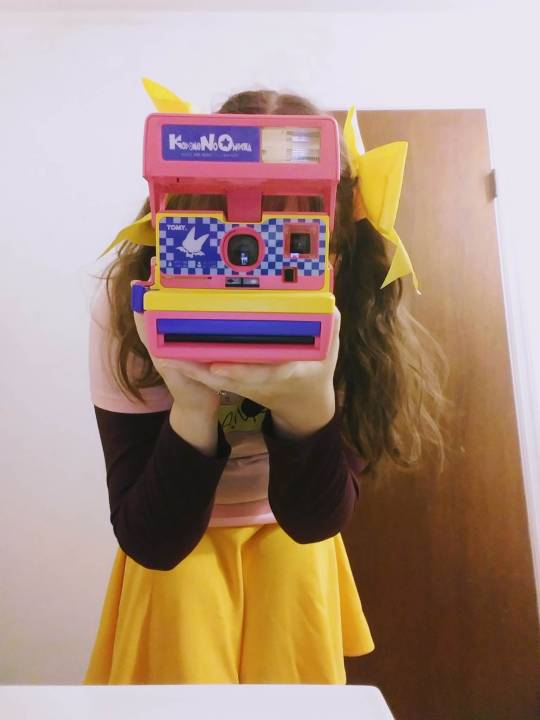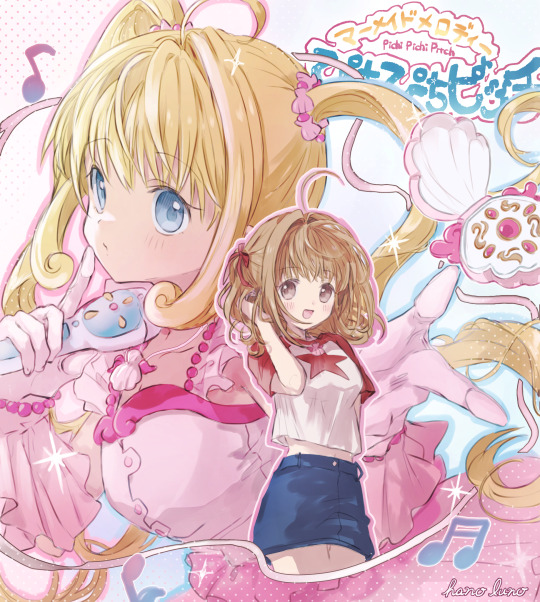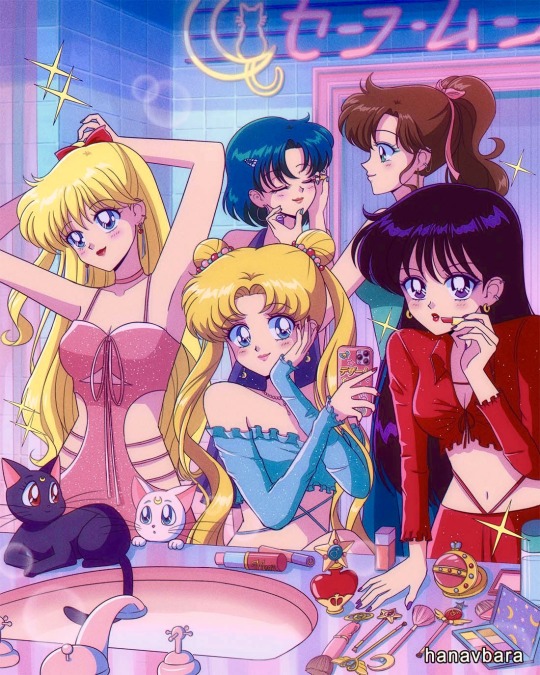Text
My Interview With Tomomi Sakai
Tomomi Sakai Interview over Email
Hi Hayden, Thank you for your patience. It takes many times longer to write in English than in Japanese.
When I automatically translate something I wrote in Japanese into English, I get sorts of strange parts. In the worst case, the content would be completely different. Automatic translation from English to Japanese is so-so, but from Japanese to English is really terrible. That is why I wrote this in English.
I have only learned English from books and radio programs and have never lived in an English-speaking country, so I know my English will be strange, but I hope I can convey what I want to say.
Q: What were some of your main inspirations for the aesthetics in Gimmick? Each stage has its own unique design and I’d be interested to hear what made you choose each particular theme and what you drew from.
A: It is difficult to answer this question. I think it is all intuitive. All I know is that it was born out of what I had seen and heard in my life up to that point. It is also influenced by Kagoya's preferences.
Q: On the topic of aesthetics, what inspired your character designs in Gimmick? Did you have separate inspirations for Yumetaro and the human characters?
A: This is the same as the question above; it was a flash of inspiration on the spot. No. It is due to the inevitability of the story.
Q: How did you come up with Yumetaro’s star move? What were the difficulties of programming the bounce physics?
A: I didn't want to make a platform game that can be cleared by firing a lot of bullets like a shooter. After accurately understanding the relationship between an enemy and Yumetaro, a player carefully hits the opponent with that one precious shot. That is the kind of game I wanted to make. For me the star program is easy.
Q: Players often struggle with reaching the good ending. Even one game over locks you out of getting it. Was this your choice or somebody else’s? Can you recall why this decision was made?
A: I hate “Continue”. However, Sunsoft's sales people order me to put “Continue” on because it sells more. That is against my principle. So, in the end, I made it so that people who continued could not finish the game. The reason why “Continue” is not allowed is that it detracts from the journey and the adventurous spirit of the game. The difficulties must be real. Fake difficulties for fun will only bring less fun than the real thing.
Q: What are your thoughts on the hobby of speedrunning? Have you watched any YouTube videos of other people playing Gimmick? How does it make you feel knowing there are people out there who try to finish the game as fast as possible?
A: It would be a way to have fun. As for the players playing, they can do whatever they want.
Q: Do you know the name of the person who created the box art of the European version of Gimmick? What else did they work on?
A: Sorry, I do not know.
Q: People have frequently made comparisons to Kirby over the years. Masahiro Sakurai even praised Gimmick! in an issue of Famitsu. What are your opinions on the Kirby franchise and Sakurai as a game developer? Do you have mutual admiration? Are there any games of his that you like?
A: I am not acquainted with him at all, but I consider him one of the great game designers.
Q: What were your expectations for the sales of Gimmick? Did you hope it would become a big success? How do you feel about the cult classic status it has now?
A: It is hard to say how well the game will sell, since factors other than the quality of the game play a large role. I can say that I am very pleased.
Q: What was your involvement with Trip World like? How much influence did you end up having on the game and how much of it was Yuichi Ueda’s unique vision?
A: Trip World is Ueda-kun's game, so please ask him. I just gave him some advice in our daily conversations.
Q: What is your opinion on Trip World as a game? What do you like about Yuichi Ueda's vision?
A: It is difficult to say anything about the game. He is good character with a love for games.
Q: Do you ever go back to play Gimmick or Trip World these days? Do you ever think about the days you were still working on those games or would you rather look at the future?
A: I think more about what I will be able to do with the rest of my life than about the past. What I wanted to do besides creating games is write books and do music. I published four books and now I want to do music.
Q: Were you close friends with Ueda at all?
A: I think I can say yes. We talked a lot about games and other things, often went to the car shop together, and went to track days together. At the time, I had a Caterham Super Seven and Ueda-kun had a Midas Gold. I think it was my influence that made him fall in love with British cars.
Q: Can you remember any specific things you suggested for Trip World?
A: No specific advice should be given. What I told him was mainly a sort of philosophy about video games.
Q: Gimmick was included in the Sunsoft Memorial collection in volume 6. Did you have any involvement with that release?
A: No, I don't know anything about it.
Q: What are your thoughts on that Playstation port and the upcoming release on Steam?
It's nice to see that more than 30 years after its release, Gimmick is still loved. My hope is that it will be offered as close to the original as possible.
3 notes
·
View notes
Text
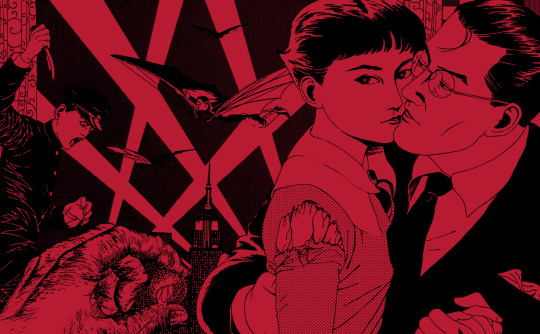
The Post-Futurist Fossils of LITCHI HIKARI CLUB
In a somewhat recent research tangent, while considering the possible “genealogy” of the Tokyo Grand Guignol’s themes and aesthetics, I made an interesting personal discovery regarding Litchi Hikari Club. Specifically some distinct thematic parallels that the play shares with the Italian futurist movement, less in relation to the art of the movement itself, but rather the ideologies of the movement’s controversial founder, Filippo Tommaso Marinetti, and his relation to the Italian fascist party. This is all of course in the context of understanding Litchi as a transgressive/dystopian horror story.
This is less of an absolute statement than it is a sort of open train of thought, so take things with a fair grain of salt. This is more or less just my own personal analysis of all the materials I could gather of the original play. Beyond inspecting the play as a possible allegory for futurism, there's also just a lot of general analysis of the play in relation to Ameya's overall body of work, both with the Tokyo Grand Guignol and also as a performance artist. I rarely put a 'keep reading' tag on these things since I'm an openly shameless product of the early days of blogging, but this one's a doozy (both in the information but also just the gargantuan length). Hopefully others will find it just as interesting.
The full essay is below...
The futurist movement itself was nothing short of an oddity. In their time, the futurists were pioneers of avant-garde modernist aesthetics, with their works ranging from deconstructive paintings to reality-bending sculptures and even early pathways to noise music with the creation of the non-conventional Intonarumori instruments of Luigi Russolo. Russolo’s own futurist-adjacent manifesto, The Art of Noises, would go on to influence such artists as John Cage, Pierre Henry, Einstürzende Neubauten and the openly left-wing industrial collective Test Department. When visiting the MOMA in New York City as a child, I was fascinated by Boccioni’s Unique Forms of Continuity in Space, a sculpture that appeared to be a spacetime malformation of the human figure encapsulated in a continual state of forward motion while in total stillness.
Despite this, the futurists were also a social movement of warmongering misogynists, with their own founding manifesto by Marinetti describing the bloodshed and cruelty of war as being “… the only cure for the world”. Their manifesto would also feature quotes such as “We want to demolish museums and libraries, fight morality, feminism and all opportunist and utilitarian cowardice”. They would originally pin anarchism as being their ideological ground in the manifesto, but shortly thereafter Marinetti would pick up an interest in fascism along with the politics of Benito Mussolini, going on to be a coauthor for the Italian fascist manifesto alongside the futurist manifesto. In consideration of how throughout most of World War II, modernist and post-modern works were considered “degenerate” forms of art in contrast with traditionalism, a whole avant-garde movement founded from fascist ideals is paradoxical. But for a period of time, that parallel wasn’t only in existence, but backed by Mussolini himself with there being a brief effort by Marinetti to make futurism the official aesthetic of fascist Italy.
One of the draws of futurism for Marinetti was an underlying sense of violence and extremity. According to Marinetti, his initial inspiration for the movement was the sensations he felt in the aftermath of a car accident where he drove into a ditch after nearly running over a band of tricyclists. He conceived his works to be acts of social disruption, intending to put people in states of unrest to cause riots and similar bouts of violence. “Art, in fact, can be nothing but violence, cruelty, and injustice”. He sought to destroy history to pave the way for a rapid acceleration to futuristic technological revelation.

“As shown in Edogawa Rampo’s Boy Detectives Club, young men like to hide from a world of girls and adulthood to form their own secret societies.” - June Vol. 27
In Litchi Hikari Club, a group of middle school-aged boys are faced with a crisis on the brink of puberty. At the twilight of their childhoods, they form a secret society known as the Hikari Club (or Light Club), a collective that’s devoted to the active preservation of their shared youth and virginity. The boys naively mimic an authoritarian organization and its hierarchy as they seek a means to preserve their boyhood, which they see as being idyllic in contrast to adulthood, a dreary state of existence that they call old and tired in the Usamaru Furuya manga version of the story. Similarly, in the Litchi Hikari Club-inspired short manga Moon Age 15: Damnation, the boys go on to liken their hideout with the paradisiacal garden of Eden. In said story, Zera would directly name the poem Paradise Lost in reference to the discovery of their hideout by adults (arriving in the form of ground surveyors) and the wide-eyed daughter of a land broker, with their contact to the virgin industrialized land being an ideological tainting of the sacred lair.
In their mission, they seek refuge in technological inhumanity by having their penises replaced with mechanized iron penises, symbolic devices of power and violence that can only procreate with other items of technology. Working in absolute secrecy, they collectively manufacture a robot known as Lychee. The purpose of Lychee, previously only known to Zera, isn’t revealed to the other club members until its completion. It’s when they unveil their “cute” robot in a scene that parallels the 1920 German expressionist film The Cabinet of Dr. Caligari that Zera tells the other members of Lychee’s purpose as a machine that would kidnap women for them. The robot's efforts are assisted by the girl capturing device, a strange rice cooker-shaped mask that’s laced with a sleeping drug. When questioned about the fuel source for the robot, Zera explains how it will run off the clean fuel of lychee fruits rather than an unsavory yet plentiful substance like electricity or gasoline as a means to further match the robot’s perceived beauty.
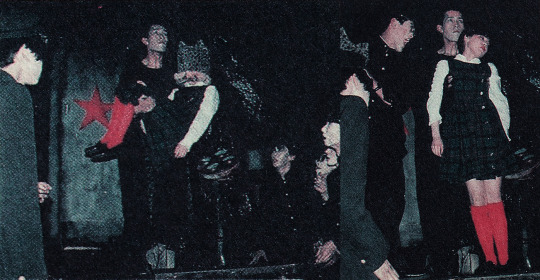
While the club share a general disdain for adulthood, they hold a special hatred to girls and women. Going off the dogmatic repulsion to sexuality that Kyusaku Shimada shows as the teacher in the Tokyo Grand Guignol’s prior play, Mercuro (1984), it could be assumed that the Hikari Club hold a similar dogmatic viewpoint about the vices of sex. In this context, it’s likely that they would’ve perceived women as being parasitic by nature as spreaders of the “old” and “tired” adult human condition through pubescent fixation and procreation. Sexual thoughts are inherent to aging for most people, given the process of discovering and exploring your identity throughout puberty. It’s that exact pubescent experience the club seek to eradicate.
Further insight is given to the Hikari Club’s dystopian psyche through their open allusions to nazi ideology. While Zera travels out to gather lychees from a tree he planted, the club get a special visit from a depraved elderly showman known as the Marquis De Maruo, performed by none other than Suehiro Maruo himself in the 1985 Christmas performance. Despite the club’s disposition to adults, they hold an exception for the Marquis for his old-timey showmanship and open pandering to the children’s whims. He always comes with autopsy films to show the young boys, and as they watch the gory videos he hands out candies that he describes as being a personal favorite of the late Adolf Hitler. He was said to also be the one to convince the boys to name their robot after the lychee fruit. It isn’t until Zera returns that the Marquis is removed from the hideout on Zera’s orders. Just before his exiling, he foretells to Zera the prophecy of the black star as both a promise and a warning to the aspiring dictator. It should be noted that there is a fascist occult symbol known as the black sun.

Suehiro Maruo as the Marquis De Maruo. On the right side is a caricature of Maruo as drawn by a contributor to June magazine, excerpted from an editorial cartoon in June Vol. 27 covering Litchi's 1985 Christmas performance.
In addition, the Marquis’ role alongside Jaibo’s appearances in the play (which I’ll get to later) show distinct parallels with the presence of the hobo in the Tokyo Grand Guignol’s first play, Mercuro. In Mercuro’s case, the hobo (performed by Norimizu Ameya, who would go on to also act as Jaibo) visits the classroom in secrecy to lecture the students his depraved ideologies. Whilst the hobo in Mercuro was a figure of perversion that existed in contrast to the teacher’s paranoid conservatism, in Litchi both Jaibo and the Marquis are enablers of the club’s fascistic leanings, with the Marquis being a promoter whereas Jaibo is a direct representation of the underlining perversions of fascist violence.
Though completely omitted from the Furuya manga, the element of the autopsy films shines a unique light on Zera’s death at the end of the story. In both the play and the manga, Zera is gutted alive by Lychee when the robot undergoes a meltdown after being forced to drown Kanon (Marin in the original play) in a coffin lined with roses. In the manga, Zera appears deeply unsettled when realizing his intestines resemble the internals of an adult. It’s unknown if this aspect is present in the theater version, as the full script remains unreleased to this day. It would fit however knowing not just the club’s repulsion to adulthood, but also how they retreat to technological modification to eradicate the human aspects they associate with adulthood. What is described of Zera’s death in the theater version has its own disquieting qualities as, from what’s mentioned, when confronted with his own mortality he appears to regress to a state of childlike delirium, a demeanor that’s drastically different from his usual calm and orderly presentation. Upon seeing his intestines, one of the responses he is able to muster is “I’m in trouble”. He says this as he questions whether or not he can fit his organs back inside the cavity before eventually telling himself that he’s just tired, that he “need(s) to sleep for a while”.

While never directly stated, it’s heavily implied that the club’s ideologies and technological fetishism ultimately root back to Jaibo, an ambiguously European transfer student who secretly manipulates the club’s actions from behind the scenes. Referred to by Hiroyuki Tsunekawa (Zera’s actor) as the “true dark emperor” of the Hikari Club, he was said to haunt the stage from the sides, closely inspecting the Hikari Club’s activities while keeping a distance. The iron phallus was first introduced by Jaibo through a monologue where he reveals how he fixed one to his own person, carefully describing its inner mechanisms and functionality before demonstrating its inhuman reproductive qualities by using the phallus to have sex with a TV. A television that he affectionately refers to as Psychic TV Chan, in reference to the post-industrial band fronted by Genesis P’Orridge. In the same scene, he promises the other members that they would all eventually get their own iron penises just like his own.
In a subsequent scene, he reveals the iron phallus’ use as a weapon when, arriving to the club’s base with a chained-up female schoolteacher who accidentally discovered the sanctuary, he uses the device to brutally kill the teacher through a mocking simulation of sexual intercourse. Just before raping her, he likens her to a landrace, bred for the sole purpose of reproducing and being processed into meat for consumption. He menacingly tells her that he will make her as “cut and dry” as her role in society before carrying out her execution. While there was some confusion on whether or not the iron phallus was a machine or solely a chastity device, it was found in bits of dialogue that the iron phallus at least shares the qualities of a pump with a described set of rubber hinges. The teacher’s death gruesomely reflects the death of Kei Fujiwara’s character in the later film Tetsuo: The Iron Man (1989), with the iron phallus mangling her insides as blood splatters across the stage. While the club treats adult sexuality as a plague, they manage to find through the iron phallus a way to convert their own states of chastity into a form of violence, stripping all humanity away from the penis and rendering it to a weapon of absolute power through desolate mechanized cruelty.
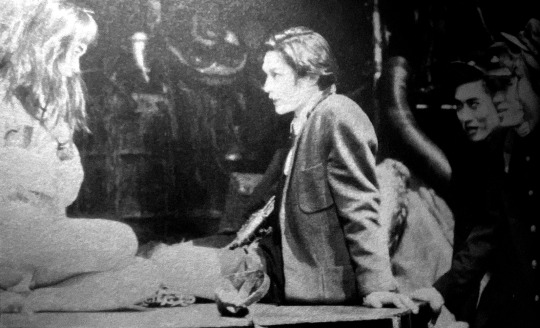
JAIBO: “Length, 250 mm, with a weight of 2.4 kilograms. Arm diameter, 30mm. Cylindrical thrust, 170mm… With pins, plates and rods of die-cast alloy. And hinges of rubber… the rest is pure iron. It is the iron phallus.” - June Vol. 27
In the same interview, Tsunekawa would go on to recall how the members of the Hikari Club were effectively Jaibo’s guinea pigs. In both the play and the manga, an after-school night of the long knives ensues with the slow collapse of the Hikari Club as Jaibo influences the exiling of certain club members, with Zera left ignorant to the social engineering as a mere extension of Jaibo’s elaborate puppeteering. Left embittered by a chess match where he lost to Zera, Tamiya is easily tricked by Jaibo into burning the lychee field as a way to get vengeance. Upon being caught, Tamiya is castrated of his iron phallus, resulting in his exiling from the club as a traitor while also being mockingly likened to a woman in the process. In another scene, it’s recalled that Jaibo and Zera exchange a conversation about the Hikari Club’s loyalty to Zera as they observe the outside world through their periscopes.
By all contemporary recollections, Jaibo was the club’s puppet master. He would’ve been the likely source of the club’s ideologies, the underlining hatred to women and fixation on technological violence, replacing mankind with a race of humanoid weapons. Zera would be a shell without his influence.
The presence of futurism could arguably even be rounded down to Lychee’s presence in the story. Beyond his theoretic work, Marinetti was also a playwright. He would be most well known for his futurist drama La donna è mobile, a story riddled with similarly perverse renditions of sexual violence. The play notably featured the presence of humanoid automatons a full decade before the term “robot” would be coined by Czechoslovakian author Karel Čapek in the play R.U.R., with the French version of Marinetti’s script referring to the machines as “puppets” for their visual similarity to humans.

All of this plays out over a soundscape that’s dominated by unnatural electronic frequencies and synthesized percussion. The sound design was arguably one of the most important aspects of Ameya’s plays, with Ameya at one point describing the Tokyo Grand Guignol productions as being an ensemble of his favorite sounds. The setting further compliments the atmosphere, made to resemble the internal of a junkyard or factory warehouse where heaps of technical jump decorate the stage around the monochrome cabinet that would eventually birth Lychee. Some of the featured artists in the play’s first act include Test Department, The Residents, 23 Skidoo and Deutsch Amerikanische Freundschaft. The play’s opening, which depicts the capturing and subsequent torture of a student named Toba through a so-called “baptism of light”, is underscored by the S.P.K. song Culturcide, a grim primordial industrial dirge that paints the image of a dystopia where the genocide of ethnic cultures is likened to the infection of human cells by parasitic pathogens. Instead of being hung with a noose, Toba is suspended by a meathook, left as a decoration amidst the heaps of mechanized excrement. He would eventually be joined by the lifeless bodies of various women the Hikari Club abduct as they’re steadily gathered in a small box at the back of the stage.
“Membrane torn apart, scavenging with the nomads. Requiem for the vestiges. Dissected, reproduced. The nucleus is infected with hybrid’s seed. Needles soak up, the weak must destroy. Cells cry out, cells scream out. Culturcide! Culturcide! Culturcide! Culturcide!” - Culturcide (from S.P.K.'s Dekompositiones EP)
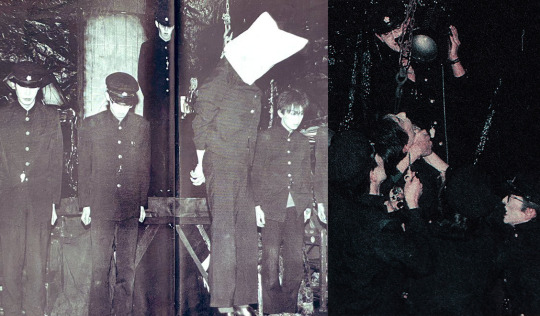
“We are now entering an era which history will come to call ANOTHER DARK AGE. But, in kontrast to the original Dark Age, defined by a lack of information, we suffer from an excess of information, which has been reduced to the repetition of media-generated signs. Through this specialization, it is no longer possible for an individual to attain a total view of society. Edukation is struktured to the performance of a limited number of funktions rather than for kreativity.”
“Kommunications systems are designed for the passive entertainment of the konsumer rather than the aktive stimulation of the user’s imagination. Through the spread of the western media, all kultures come to stimulate one another. By the end of the millennium, this biological infektion will have penetrated the heart of the most isolated traditions - a total CULTURCIDE.”
“Yet in every era, a small number of visionaries rise above the general malaise. Those who will succeed, will resist the pressure to become kommercialized “images”, demanding identifikation and imitation. They will uphold their principles in the face of impossible odds. By remaining anonymous, they will be free to develop their imagination with maximum diversity. For this is the TWILIGHT OF THE IDOLS, - the end of the proliferation of the ikons and the advent of a new symbolism.” - From the back cover of S.P.K.’s Dekompositiones EP (released under the moniker SepPuKu)
Over the course of the play, the story undergoes a drastic tonal shift as the focus moves from the Hikari Club’s hierarchical order and internal conflicts to the relationship between Lychee and Marin. Marin (performed by synthpop musician Miharu Koshi) was the first girl the Hikari Club successfully kidnap through Lychee after implementing the phrase “I am a human” in Lychee’s coding so it can understand the concept of human beauty. This small implementation causes a full unraveling in Lychee’s personality as it quickly forms a close bond with Marin, convinced that it is also a human like Marin. The soundscape changes alongside the overarching atmosphere, going from cold industrial drones and percussive electronica to ambient tracks. Some of the major scenes play out over moving piano-focused pieces and music box tunes from Haruomi Hosono’s soundtrack for Night on the Galactic Railroad. Originally created a weapon like the iron phalluses and the girl capturing device, Lychee is eventually defined in how he transcends from being a weapon to a conscious being with feelings. In this context, the play can be read as a juxtaposition of human emotion against inhuman futurist brutality.
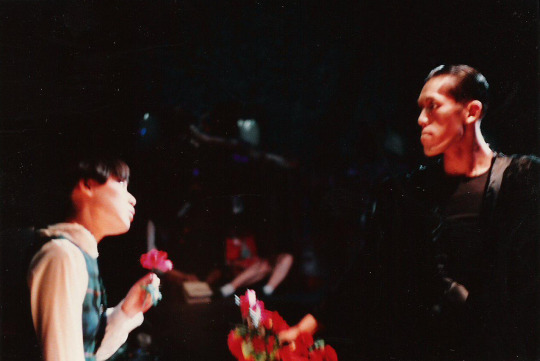
This split was likely the product of the radically different creative ideologies of Norimizu Ameya (the Tokyo Grand Guignol’s founder and lead director) and pseudonymous author K. Tagane (the playwright for the group from Mercuro to Litchi). Ameya had come into the group with radical intentions, holding Artaudesque aspirations to transgress the literary limits of modern theater to achieve something deeply subconscious. Meanwhile, Tagane was a romantic who was known for their poetic and lyrical screenplays. Ameya purportedly sought out Tagane’s screenplays specifically to find a literary base he would “destroy” in his direction, deconstructing the poeticisms in his own unique style. He describes it briefly in an interview regarding the stage directions of Mercuro, stating how he took elaborate descriptions of a lingering moon and ultimately deconstructed them to the moon solely being an illusion set by a screen projector, mapping out the exact dimensions of the projection to being a 3-meter photograph of the moon rather than a “fantastic moon”. It’s believed by some that the Tokyo Grand Guignol’s formation and ultimately short run were the product of a miraculous balance between Ameya and Tagane’s ideologies. It’s possible that Litchi could’ve been a last straw between the two artists. After Litchi, Tagane left the group, with Ameya having to write the troupe’s final screenplay on his own.
LYCHEE: “Marin is always sleeping… all she does is sleep. She doesn’t eat anything. Why does Marin sleep all day?”
MARIN: “When you’re asleep, all the sadness of the world passes over you.”

"The second half of Litchi was predominantly driven by the sounds of Ryuichi Sakamoto and Haruomi Hosono. During a scene that featured a piece from the Galactic Railroad soundtrack, Miharu Koshi sang to Kyusaku Shimada while dancing like a clockwork doll to the sounds of a twisting music box. The scene lasted for a while and was very romantic, the interactions between Lychee and Marin were all very sweet and cute. The second act of Litchi was all a product of Tagane’s making. By the time of the following play, Walpurgis, I was told by a staff member that Ameya had written the screenplay by himself because Tagane had left.”
“… While the first half was filled with repeated mantras and the unfolding aesthetics of an aspiring militia, the second half was immersed in the world of shoujo manga. It did appear that through the intermission, much of the junk and rubble around the podium was sorted out.”
“… The Tokyo Grand Guignol’s plays were always defined by a strong nocturnal atmosphere. But in Litchi’s second half, it wasn’t a dark night, but a brightly lit one under the moonlight and plentiful stars in the sky shining through an invisible skylight. Marin doesn’t forgive Lychee immediately for his actions, responding to him harshly in a way that would confuse him and make him sulk. It came across as a somewhat bitter reimagining of a French comedy like Louis Malle’s Zazie dans le Métro or Jean-Pierre Jeunet’s Amélie, it was different that way in how it wasn’t only Maruo’s inferno.” - From a Twitter thread by user Shoru Toji regarding the 1986 rerun of Litchi Hikari Club
Some questionable qualities do exist in the relationship between Lychee and Marin. What should be a peaceful retreat from the dystopian corruption still has a sinister undertone in the disparities between Lychee’s cold masculine features in contrast with Marin’s childlike girly innocence. It doesn’t help that Zazie dans le Métro (one of the mentioned films in the recollection) was directed by Louis Malle, who while known for such films as My Dinner With Andre and Black Moon was also responsible for the infamously discomforting Pretty Baby. Then again, Litchi was the product of a confrontational transgressive subculture, so the sinister undertones could be intentional. Keep in mind the contents of Suehiro Maruo’s prolific adaption of Shōjo Tsubaki and how it unflinchingly depicts abuse and manipulation through the eyes of a confused child.
It could be possible that Lychee himself was intended to be childlike in its mannerisms. Throughout the existing descriptions, Lychee was shown as speaking in fragmented sentences while struggling to understand basic concepts. Zera was mentioned to also use certain phrases like “cute” when referring to the robot when it was unveiled. And it’s through Marin that Lychee learns morality like a child. The robot’s masculinity could be passed off as the cast all being adults. Hiroyuki Tsunekawa for instance shows distinctly sculpted features from certain angles when performing Zera.

In his aspirations to become a human, Lychee eventually “dies” like a human. With the burning of Zera’s lychee tree, the robot is left with a finite limit on its remaining energy before it totally loses consciousness. After his rampage, Lychee attempts to reunite with Marin, but he runs out of fuel. Before what should be a moment of resolution, things are cut short as the stage goes black, eventually illuminated to show an unpowered Lychee cradling Marin’s corpse in his arms. Zera reemerges to observe the remnants of Lychee and Marin. He speaks of how Lychee will crumble into nothingness alongside Marin for foolishly giving into human emotion, further implying the club’s views on humanity. After this, recollections of the play’s final lines differentiate somewhat. It was said that in the original Christmas performance, Zera calls out to Jaibo, posing the corpses of Lychee and Marin as being his seasonal gifts to Jaibo. Whereas in most popular recollections, it’s described that after his monologue, Zera shouts “Wohlan! Beginnen!” (German for “Now! Begin!”) before prompting the decorations across the stage to collapse, revealing a set of stepladders from behind that the remaining previously deceased club members stand, all drenched in blood with spotlights illuminating their faces from below.
ZERA: “And with that, our tale of a foolish romance between woman and machine reaches its conclusion. It ends before me as I stand here, watching. Lychee, the machine, will rust away into dust. And Marin, a young girl, will rot away leaving behind only her bones, which too will crumble…”
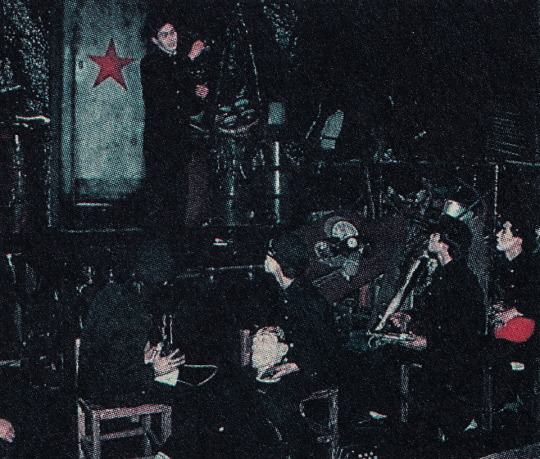
Multiple readings can be deciphered from this conclusion. The most established theory is in relation to the Hikari Club’s aspirations for eternal youth, with the members technically achieving their goal through the stagnation of death. They will remain eternal children since they died as children, unable to ever grow into adulthood. In the context of futurism and mechanized fascism however, it could be read as a bitter observation of a lasting dictatorship. With how the Hikari Club members had rendered themselves less human than their own robot, they survive death to continue their work, seeking to one day eradicate humanity in favor of a race of sentient childlike weapons.
“To admire an old picture is to pour our sensibility into a funeral urn instead of casting it forward with violent spurts of creation and action. Do you want to waste the best part of your strength in a useless admiration of the past, from which you will emerge exhausted, diminished, trampled on?”
“… For the dying, for invalids and for prisoners it may be all right. It is, perhaps, some sort of balm for their wounds, the admirable past, at a moment when the future is denied them. But we will have none of it, we, the young, strong and living Futurists! Let the good incendiaries with charred fingers come! Here they are! Heap up the fire to the shelves of the libraries! Divert the canals to flood the cellars of the museums! Let the glorious canvases swim ashore! Take the picks and hammers! Undermine the foundation of venerable towns! The oldest among us are not yet thirty years old: we have therefore at least ten years to accomplish our task. When we are forty let younger and stronger men than we throw us in the waste paper basket like useless manuscripts! They will come against us from afar, leaping on the light cadence of their first poems, clutching the air with their predatory fingers and sniffing at the gates of the academies the good scent of our decaying spirits, already promised to the catacombs of the libraries.” - from the 1909 Futurist Manifesto by Filippo Tommaso Marinetti

I forgot what exactly first caused the parallel to cross my mind. I do recall it being reignited when having a closer look over the poster and flyer for Litchi’s Christmas performance in December 1985. The flyer in particular is really a wonderful thing to look at. Predominantly featuring an art spread by Suehiro Maruo, a suited man with Kyusaku Shimada’s likeness is shown caressing a girl in front of a modernist cityscape with spotlights shining up to a night sky. Other suited men in goggles fly in the air with Da Vinci-reminiscent flying apparatuses between the beams of the metropolis’ spotlights. A student in full gakuran uniform flings himself into the scene from the far left side of the image with a dagger in hand, and a larger hand comes from the viewer’s perspective holding a partially peeled lychee fruit. While not based on any direct scene from the play, it perfectly instills the play’s atmosphere with an air of antiquated modernity, like the numerous illustrations of the early 1900s that show aspirational visions of what a futuristic cityscape might resemble. The bizarre neo-Victorian fashions of the future and its post-modernist formalities. The term futurism came to mind somewhat naively from this train of thought. It was a movement I recalled hearing about, but my memory of it was hazy. It wasn’t until I went in for a basic refresher that I felt the figurative lightbulb go off in my head. That was when the pieces started to come together, but then also strain apart from each other into tangents.
Granted, many of these parallels could be read as coincidental. Many of them can even be passed off the play being a work of proto-cyberpunk, knowing how Tetsuo: The Iron Man would subsequently explore similar themes of cybernetics and human sexuality. It should still be noted however that in contrast with many of the Japanese cyberpunk films, Litchi was explicit in its connotations between technological inhumanity and fascism, with the machinery itself being the iconography of a dictatorship rather than a product of it. In addition, with Tetsuo the film has strong gay overtones, with the technology being an extension of the sexual tensions between the salaryman and the metal fetishist. For a period of time, efforts were made to make futurism the official aesthetic of fascist Italy, and modern fascism as we know it is in the same family tree of Italian philosophy as futurism. The Hikari Club are explicit in drawing from German aesthetics rather than Italian however, speaking in intermittent German and predominantly using German technology. The spotlight that they used when torturing Toba in the first act, for example, was a Hustadt Leuchten branded spotlight. And if that isn’t a German name I don’t know what is. It was also said that Jaibo’s outfit in the play was modeled after German school uniforms. Though then again, the Tokyo Grand Guignol’s works were a bit of a cultural slurry. Jaibo’s name for example is Spanish (derived from Luis Buñuel’s Los Olvidados), while the character is implied to be German.
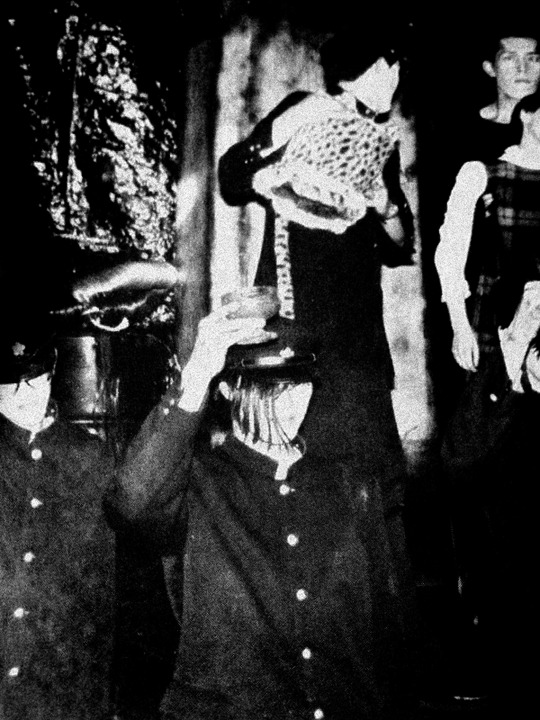
Similar to the cited origins of futurism, Ameya stated in a 2019 tweet regarding the June 9th, 1985 abridged Mercuro performance on Tokumitsu Kazuo’s TV Forum that in the following August of that year, an airplane accident occurred that led to the conception of Litchi’s screenplay. The exact nature of the accident was never specified, but the affiliates he was communicating with all appeared to be familiar with it and expressed concern when it was brought up. This was however one of an assortment of influences that were cited behind Litchi’s production, with the two more established theories regarding the then-contemporary mystique around lychee fruit in Chinese cuisine along with the play being a loose adaption of Kazuo Umezu’s My Name is Shingo.
For what it’s worth, the themes of Litchi, along with the Tokyo Grand Guignol’s other works, were closely tied with certain concepts that Ameya personally cultivated throughout his career. A frequent recurring topic Ameya would bring up in relation to his works was the nature of the human body in relation to foreign matter, need it be biological or unnatural. With Mercuro the students taught by Shimada are made into so-called Mercuroids by having their blood supplies replaced with mercurochrome, a substance that is referred to as the “antithesis of blood” by Shimada while in character. In an interview for the book About Artaud?, Ameya cites an interest in Osamu Tezuka’s manga in how certain stories of Tezuka’s paralleled Ameya’s observations of the body. He directly names Dororo and Black Jack, observing how both Hyakkimaru and Black Jack reconstructed their bodies from pieces of other people, going on to bluntly describe Pinoko as a “mass of organs covered in plastic skin”.

A section from June Vol. 27 highlighting some of the more established performers from Litchi's 1985 Christmas performance. The actors from left to right are Norimizu Ameya as Jaibo, Naomi Hagio as the female school teacher (best known in cult circles for her role as Kazuyo in the 1986 horror film Entrails of a Virgin), Suehiro Maruo out of costume and Miharu Koshi as Marin.
During his temporary retirement from theater, Ameya would take up performance art, with some of his performances revolving around acts with his own blood. While my memories of these works are a bit hazy, I remember one action he performed that involved a blood transfusion, with the focus being on the experience of having another person’s blood coursing through your veins. While I didn't have much luck relocating this piece (probably from it not being covered in English), I did find on the Japan Foundation’s page for performing arts an interview where Ameya discusses being in a band with Shimada where Ameya had blood drawn from his body while he played drums. He would also describe an art exhibition where he displayed samples of the blood of a person infected with HIV.
“After 1990 he left the field of theatre and began to engage himself with visual arts - still proceeding to work on his major topic - the human body - taking up themes like blood transfusion, artificial fertilization, infectious diseases, selective breeding, chemical food, and sex discrimination, creating works as a member of the collaboration unit Technocrat.” - Performing Arts Network Japan (The Japan Foundation)
There are still an assortment of open questions I’m left with in regards to the contents of the original Litchi play. One of the most glaring ones is Niko’s eye. In consideration of Ameya’s interest in the body, the detail would fit perfectly with his ideologies. A club member who, to show his absolute loyalty to the Hikari Club, has his own eyeball procedurally gouged out to be made a part of the Lychee robot. Despite this perfect alignment, none of the contemporary recollections mention this element. While Niko does have an eyepatch in certain production photos, it never seems to come up as a plot point. He isn’t the only one to bear an eyepatch either, with Jacob also being shown with an eyepatch in flyers. More questions range from Jaibo’s motives in causing the dissolution of the Hikari Club to the true nature of Zera’s affiliation to Jaibo. While Tsunekawa has stood his ground in the relationship between Zera and Jaibo being totally sexless, in the cited volume of June the editor playfully refers to Jaibo as being Zera’s “best friend” in quotes.
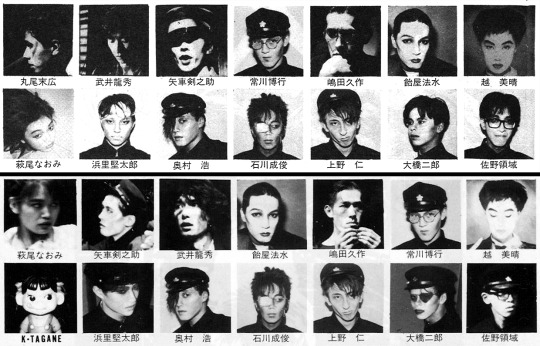
A side-by-side comparison of the cast listings on the back of the flyers for the December 1985 performance of Litchi Hikari Club alongside its 1986 rerun. The 1985 run's lineup is at the top while the 1986 run is at the bottom.
Much speculation is naturally involved when looking into the original Litchi Hikari Club since it is in essence a cultural phantom. There’s a reason I used the term genealogy in relation to my research of the Tokyo Grand Guignol’s works. It is an artistic enigma as while its presence lingers in subculture, the original works are now practically unattainable due to the inherent nature of theater. As Ameya himself would acknowledge in another interview, theater is an immediate medium that can only be perceived in its truest form for a very short span of time before eventually disintegrating. So with the Tokyo Grand Guignol’s plays, you are left to scour through the scattered remnants and contemporary recollections alongside the figurative creative descendants of the plays. You analyze the statements of both the original participants and the people they openly dismiss, as even those people were original audience members before reinterpreting the plays to their own unique visions. Despite the apparent differences, I still feel that Furuya’s manga gives a unique perspective to the story when viewed under dissection. That is if you want to see it in strict relation to the play. Outside that, I feel it firmly stands on its own merits. I like the manga no matter what Tsunekawa says, that’s what I’m trying to say. Ameya approved it anyway.
It took me a full day to write all this out, and like the first time I went down this train of thought, I’m pooped. During that first excursion, after excitedly spiraling through these potential connections, I noticed in passing mention something about Marinetti’s cooking. You see, later in his life Marinetti aimed to apply futurism not just to art and theater, but cuisine also. As an Italian, Marinetti openly despised pasta, seeing it as being an edible slog that weighs down the spirits of the Italian people. Just further evidence that I would never get along with the man, no matter my liking of the Boccioni sculpture I saw at MOMA all those years ago. Well, outside of him being a fascist and all obviously. I like pasta. Either way, he was on a mission to conceive all-new all-Italian cuisines that would match the vision he had of a new fascist Italy. Nothing could prepare me though for when I saw an image of what would best be described as a towering cock and ball torture meat totem. It is exactly as it sounds, a big phallic tower of cooked meat with a set of gigantic dough-covered balls of chicken flesh on the front and back where you have to stick needles through the thing to hold it together. Words cannot express just how big it is. The thing was damn well near falling apart from how unnatural its shape was, and you’re expected to eat it while it has honey pouring from the tip of the tower. I genuinely winced watching its assembly, I instinctively crossed my legs somewhat when it was pierced by wooden sticks and then cut into sections to reveal the plant-stuffed interiors. As a person with no interest whatsoever in cooking shows, I was on the edge of my seat watching a PBS-funded webisode of someone preparing futurist dishes. Seek it out for yourself, it’s an excessively batshit culinary freakshow.
That is more than enough talk about penises for the rest of the week. I’m going to spend the next few days looking at artistic yet selectively vaginal flowers to balance things out, equal opportunity symbology.

133 notes
·
View notes
Text


Re-opening my patreon!
I used to put my clip studio files and speedpaints here along with cheaper commissions … I’m doing the first two again!
I might also have longer real-time drawing videos but I’m just trying to make this whole endeavor “keep me not destitute”-able again while I’m saving up to move.
Either way I’m gonna be more active posting now, hopefully it works out lol
57 notes
·
View notes
Text
▶️🎉1 Year on YouTube ▶️ 🎉
Today marks my 1 year anniversary of being a YouTuber. When I started creating Kodocha videos, I never expected to make so many new friends and gain so many subscribers who feel just as passionately as I do about the series.
Thank you ALL.
Not only did I become a YouTuber last year, but I also became a wife and an official resident of a new state in the US. 2022 was a big, and difficult year for me. With all the changes and adjustments going on around me, it was comforting knowing that I had the Kodocha community to go back to each day.
So what inspired me to create a Kodocha channel? There are many reasons, so let’s talk about them! First of all, Kodocha is my favorite animanga series, and sadly there isn’t many Kodocha content creators online. However, the ones that do exist do such AMAZING work for this fandom. I want to give a shout-out to my friend Li over on Twitter (https://twitter.com/kodomonomochaa) for her incredible work gathering Kodocha media and resources for fans to enjoy. She has been a big part of my channel’s growth and is just a sweet person all around. Make sure to give her a follow on all her platforms!
I also want to give a shout-out to @thekodochaarchive, another great resource for fans to see rare content. There is a lot of interesting rare Kodocha media over on that blog/channel, I highly recommend checking it out! Watching the old Kodocha commercials is like being able to go back and time and experience Kodocha at the time when it was first being aired. I would have loved to have been a kid who grew up with that show!
Last but certainly not least, I want to give a HUGE shout-out to my girl @dailykodocha aka M, who runs the BEST Kodocha blog around and writes INCREDIBLE fanfiction. Please go and check out her fic about Akito during the middle school years; it’s SO good and she gets the characters so well. It feels like it could be an official Kodocha novel. Here’s the link to that! (https://archiveofourown.org/works/41971272?view_full_work=true) She also co-hosts our unofficial Kodocha podcast, “19 O’Clock News” with me. We have so much fun with it, and I look forward to sharing many many many more episodes with everyone!
So wanting to contribute more to a series I deeply love, I decided to create my YouTube channel, as I noticed there weren’t really any video essays about Kodocha anywhere. This felt wrong given how much there is to talk about with the series, and how deep the characters are.
Many of the videos that you’ve watched from me for most of 2022 were formulated from ideas I’ve had in my head since I first saw the series back in 2016. That’s why I was uploading almost weekly, as the writing flowed so naturally as I’d had a lot of time to think about the characters and plot.
I’m very proud of all the content I have put out thus far - but I will keep improving! I’ve been re-reading the series and am about to finish volume 10, and noticed some things that I should have talked about in previous videos. It’s crazy just how detailed Obana was when she wrote Kodocha! Just when I think I understand a character, I notice a new detail during a read-through and it completely shifts my perspective on them. I used to feel very indifferent about Fuka until pretty recently! Now she is becoming one of my favorite characters.
Another reason I started my channel was for my mental health. Being creative is what keeps me sane. Unfortunately, making music (my main creative hobby) just didn’t have the same spark for me anymore. It used to be my go-to activity for my mental health - but I think I had done it for so long that I got burned out. Also, I felt very limited in what I could do with music, but with my channel, I feel like I can exercise and hone my writing skills and also talk about something I love in a unique way. This summer, I created a second channel which I hope to upload more content on that focuses on obscure media, which I will use as another outlet to discuss things unrelated to Kodocha. I watch YouTube more than anything and would love to create similar content to YouTubers that I enjoy, where they talk about interesting things from childhood or just niche internet mysteries.
Kodocha is the only thing in my life that has ever consistently brought me joy. Ever since I found the series, it’s turned my life around in more ways than one. When I first watched the anime in 2016, it made what could have been a miserable year for me into something hopeful. Sana’s enthusiasm and positivity really awakened my own, and it’s stuck with me ever since. Maybe taking life so seriously isn’t the answer. Sometimes you just gotta shut up and smile, and not worry about things you can’t fix, and just go with the flow. I never knew by 2023 Kodocha would have brought me so many new friends and just a better understanding of myself and life in general. I hope everyone watching my videos can learn not only about the characters of Kodocha, but about themselves as well. My latest video, part 2 of “Exploring Sana & Akito’s Relationship”, actually helped me in my own marriage. Yesterday, my husband told me that he’s the happiest he’s ever been. It made me feel so good because the research and time I put into that video helped me better understand my husband’s love languages, which ultimately strengthened our marriage.
Kodocha really is my light in this dark world and I hope I am able to spread the joy that it’s instilled in me.
Thank you for reading, and sticking around until now. There is a lot more Kodocha content coming in the future, as always. See ya! 💖
13 notes
·
View notes
Text

Halfway through my goal! I wanted to reach 5,000 subscribers before the end of the year. More shoujo/magical girl videos will be on their way. I have faith in myself!
#anitube#anime youtube#shoujo#shoujo anime#shoujo manga#magical girl#mahou shoujo#nonbinary#non biney
0 notes
Photo
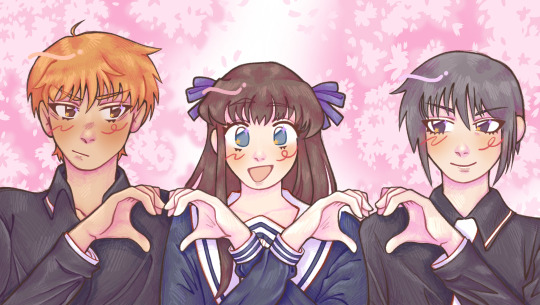
New video! The FRUITS BASKET PROBLEM
Watch here: https://www.youtube.com/watch?v=hgbDHEye_Xk
Art by https://twitter.com/aime_bun
#fruits basket#furuba#studio deen#natsuki takaya#2001#anime#analysis#anitube#aesthetic#y2k#2000s#early 2000s#manga#kodocha#kodomo no omocha#nurse angel ririka sos#bokura ga ita#akazukin chacha
67 notes
·
View notes
Photo

Sailor Moon has something fishy about it, and that is its connection to Goldfish Warning! In this video I explain how Sailor Moon took influence from Goldfish Warning, as well as showing some neat easter eggs you might not have known about.
Link to video: https://youtu.be/ZAZx3OjwtMw
#sailormoon #naokotakeuchi #toei #toeianimation #goldfishwarning #sailormercury #sailormars #sailorjupiter #sailorvenus #sailorv #codenamesailorv #kunihikoikuhara #junichisato #90s #anitube #anituber #90saesthetic #90sanime #videoessay
6 notes
·
View notes
Photo

To celebrate its 30th anniversary, I present to you the untold story of Mr Gimmick. For this video I interviewed Tomomi Sakai, the creator of the game, to bring you completely new information. Enjoy the art from all the wonderful artists I brought on! (Thumbnail by @rainbowheartunicorn)
https://youtu.be/S1aZxyCJgSc
#nes#retro gaming#90s#sunsoft#mr. gimmick#gimmick!#art#fanart#nintendo#famicom#pixel art#trip world#galaxy fight#gameboy#gameboy color
27 notes
·
View notes
Photo

Every Cardcaptor Sakura game (Officially released console games)
#cardcaptor sakura#90s aesthetic#clamp#2000s#retro gaming#ps1#gba#gbc#ps2#dreamcast#wonderswan#early 2000s#aesthetic
22 notes
·
View notes
Text

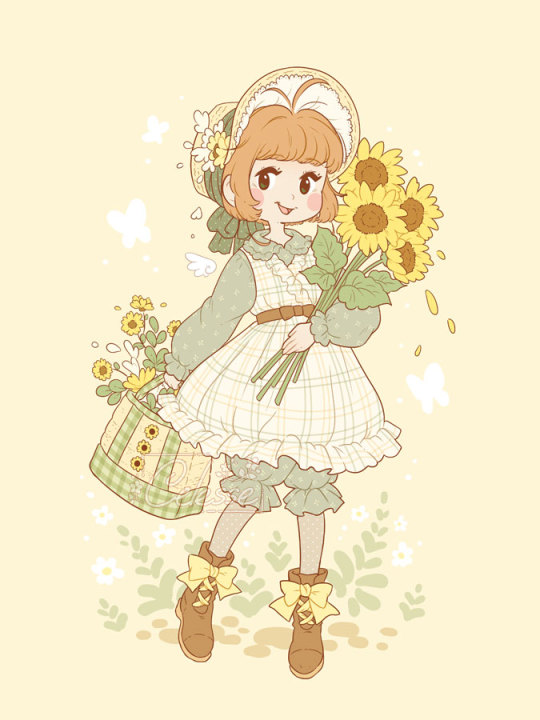

Happy birthday to my favorite magical girl 🌸💕
6K notes
·
View notes




